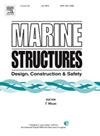The inversion investigation of wave slamming response of air cushion vehicle skirt airbags based on mode superposition method
IF 5.1
2区 工程技术
Q1 ENGINEERING, CIVIL
引用次数: 0
Abstract
Air cushion vehicle (ACV) skirt airbags frequently encounter direct wave slams, which involve large deformations and complex gas-liquid-solid three-phase coupling. The direct slamming energy will break diverse sensors, bringing huge difficulty to accurately monitor the dynamic response among slamming areas. To effectively derive the dynamic behavior of ACVs under wave slamming, this paper identifies the response of the limited monitoring points outside the slamming area, then inverses the skirt airbag slamming response based on modal superposition and the least squares method. Firstly, a 3D finite element model of the skirt airbag is developed. The control volume method is used to simulate the inflated-forming process, and the overall modes database of the airbag is obtained. Next, based on the load forms, modal characteristics, and response features, the monitoring point arrangement and fundamental modal selection are determined. Finally, the inversion algorithm is employed to update modal weight factors in real time then superposing them to predict the focused response in the slamming areas. The proposed inversion method is applied to different scenarios with both symmetrical and asymmetrical loads, to verify the stress response prediction accuracy. The error between the inverted response and the actual response remains almost within 10 %, and the inversion method shows good numerical stability. The inversion method is convenient to implement with a friendly computation time and provides valuable insights for the consequent investigation into the complicated dynamic behaviors of ACV flexible airbags under actual marine environments.
基于模态叠加法的气垫汽车裙边安全气囊波浪撞击响应反演研究
气垫车裙边安全气囊频繁遭遇直接冲击,冲击变形大,气液固三相耦合复杂。直接的撞击能量会破坏各种传感器,给精确监测撞击区域间的动态响应带来巨大的困难。为了有效地推导波浪撞击作用下acv的动力特性,首先识别撞击区域外有限监测点的响应,然后基于模态叠加和最小二乘法反演裙边气囊的撞击响应。首先,建立了裙边气囊的三维有限元模型。采用控制体积法对充气成形过程进行了仿真,得到了气囊整体模态数据库。其次,根据荷载形式、模态特征和响应特征,确定监测点布置和基本模态选择。最后,利用反演算法实时更新模态权重因子,并将其叠加,预测碰撞区域的聚焦响应。将所提出的反演方法应用于对称荷载和非对称荷载的不同场景,验证了应力响应预测的准确性。反演结果与实际误差基本保持在10%以内,且反演方法具有较好的数值稳定性。该方法实现方便,计算时间短,为后续研究ACV柔性安全气囊在实际海洋环境下复杂的动力学行为提供了有价值的见解。
本文章由计算机程序翻译,如有差异,请以英文原文为准。
求助全文
约1分钟内获得全文
求助全文
来源期刊

Marine Structures
工程技术-工程:海洋
CiteScore
8.70
自引率
7.70%
发文量
157
审稿时长
6.4 months
期刊介绍:
This journal aims to provide a medium for presentation and discussion of the latest developments in research, design, fabrication and in-service experience relating to marine structures, i.e., all structures of steel, concrete, light alloy or composite construction having an interface with the sea, including ships, fixed and mobile offshore platforms, submarine and submersibles, pipelines, subsea systems for shallow and deep ocean operations and coastal structures such as piers.
 求助内容:
求助内容: 应助结果提醒方式:
应助结果提醒方式:


